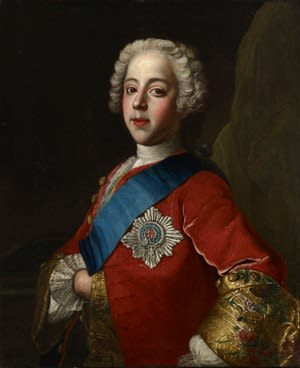
Liotard, Follower of Jean-Etienne
Portrait of Charles Edward Stuart (1720-88), ‘Bonnie Prince Charlie’
Oil on canvas
28 x 22 ¾ in (71 x 58 cm)
Philip Mould & Co.
To view all current artworks for sale visit philipmould.com Bonnie Prince Charlie is known to history as one of the most romantic rebels ever to launch a claim for...
To view all current artworks for sale visit philipmould.com
Bonnie Prince Charlie is known to history as one of the most romantic rebels ever to launch a claim for the crown. As the son of the exiled Old Pretender, James III, and the grandson of James II, Charles’s claim to the throne was based on his direct descent from the Stuarts, as opposed to the convoluted descent of the German Hanoverians who occupied the throne after the death of Queen Anne. However, Charles’s chances of ever regaining the kingdoms of Scotland and England for the Stuarts looked impossibly slim when, in 1745, he decided, with only a handful of supporters, to lead a revolt in Scotland.
Despite little money and few arms, he rapidly succeeded in raising the Highlanders to his standard, and was soon in Edinburgh, where his father was proclaimed King. In London, there was general panic, and when news was received that Charles’s army had reached as far south as Derby, many assumed that the Hanoverian’s days were numbered. The Scots army that Charles led was, however, poorly supplied and ill-disciplined, and was chased back into Scotland by the Duke of Cumberland, known, after Charles’s final defeat at the Battle of Culloden in 1746 as ‘Butcher’ Cumberland. Thereafter Charles roamed Europe in the futile hope of reviving international support for another invasion. He died without a legitimate heir, and his claim to the throne was taken up by his brother, Cardinal York, the last of the Jacobites.
In his book ‘The King over the Water’, the Jacobite scholar Edward Corp identifies this portrait type with Jean-Etienne Liotard, who was commissioned to paint James III and both his sons in Rome in 1737. Liotard’s original pastel of Charles is now lost, and is therefore recorded only in a handful of versions by other artists, of which the present portrait is one. Two other versions are in the Scottish National Portrait Gallery, one of which shows the Prince in tartan. Such portraits were vitally important to the exiled Stuarts, and acted as a means of keeping the cause alive amongst their Jacobite supporters and sympathetic governments in Europe. Pictures of the young Prince were particularly valued, for part of his political significance lay in the fact that he was a boy, whereas the line of succession from James II’s daughters Mary and Anne, who were conspicuously unable to provide any Stuart heirs themselves, had failed, thus leading to the imposition of the Hanoverians. The likeness seen here expresses the optimism and idealism of ‘the Bonnie Prince’, and contrasts sharply with the iconography of the sad and defeated Charles at the end of his life.
Bonnie Prince Charlie is known to history as one of the most romantic rebels ever to launch a claim for the crown. As the son of the exiled Old Pretender, James III, and the grandson of James II, Charles’s claim to the throne was based on his direct descent from the Stuarts, as opposed to the convoluted descent of the German Hanoverians who occupied the throne after the death of Queen Anne. However, Charles’s chances of ever regaining the kingdoms of Scotland and England for the Stuarts looked impossibly slim when, in 1745, he decided, with only a handful of supporters, to lead a revolt in Scotland.
Despite little money and few arms, he rapidly succeeded in raising the Highlanders to his standard, and was soon in Edinburgh, where his father was proclaimed King. In London, there was general panic, and when news was received that Charles’s army had reached as far south as Derby, many assumed that the Hanoverian’s days were numbered. The Scots army that Charles led was, however, poorly supplied and ill-disciplined, and was chased back into Scotland by the Duke of Cumberland, known, after Charles’s final defeat at the Battle of Culloden in 1746 as ‘Butcher’ Cumberland. Thereafter Charles roamed Europe in the futile hope of reviving international support for another invasion. He died without a legitimate heir, and his claim to the throne was taken up by his brother, Cardinal York, the last of the Jacobites.
In his book ‘The King over the Water’, the Jacobite scholar Edward Corp identifies this portrait type with Jean-Etienne Liotard, who was commissioned to paint James III and both his sons in Rome in 1737. Liotard’s original pastel of Charles is now lost, and is therefore recorded only in a handful of versions by other artists, of which the present portrait is one. Two other versions are in the Scottish National Portrait Gallery, one of which shows the Prince in tartan. Such portraits were vitally important to the exiled Stuarts, and acted as a means of keeping the cause alive amongst their Jacobite supporters and sympathetic governments in Europe. Pictures of the young Prince were particularly valued, for part of his political significance lay in the fact that he was a boy, whereas the line of succession from James II’s daughters Mary and Anne, who were conspicuously unable to provide any Stuart heirs themselves, had failed, thus leading to the imposition of the Hanoverians. The likeness seen here expresses the optimism and idealism of ‘the Bonnie Prince’, and contrasts sharply with the iconography of the sad and defeated Charles at the end of his life.
Provenance
Scottish Private Collection
Be the first to hear about our available artworks
* denotes required fields
We will process the personal data you have supplied in accordance with our privacy policy (available on request). You can unsubscribe or change your preferences at any time by clicking the link in our emails.